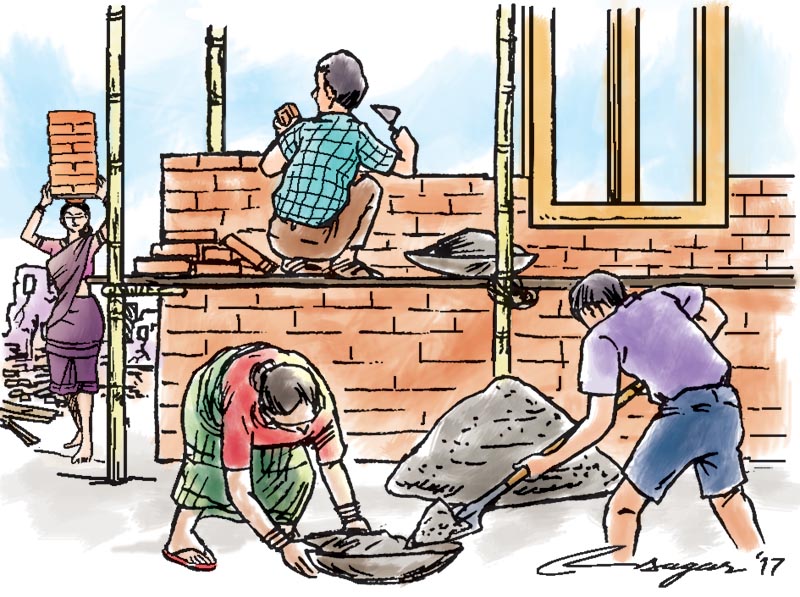Earthquake disaster: Reconstruction and recovery
It was found that, villages with good road access, higher wealth and family member sending remittance were generally rebuilt faster. Secondly, people have started borrowing mainly from informal sources with increased risk of debt traps
The catastrophic earthquakes of 25 April and May 12, 2015 led to unprecedented loss of lives and properties. Approximately 9,000 people lost their lives, more than 22,300 people were injured, about 6,00,000 houses were damaged and they affected millions of people. Additionally, more than 7,000 schools and 3,000 government buildings were demolished.
The total value of disaster effects (damages and losses) earthquakes is estimated to be about NRs. 706 billion (US$ 7 billion) that is equivalent to about one third of the Gross Domestic Product (GDP). Out of the total value, the share of destroyed physical assets accounts for NRs. 517 billion (76% of the total effects). The PDNA report reveals that the share of the disaster effects across sectors was estimated as: social sector (58%), productive sector (25%), infrastructure sector (10%) and cross-cutting issues (7%).
Similarly, the earthquake had negative impact on production, trade, agriculture, tourism, thereby weakening the national economy. The average economic growth was about 3% in fiscal year 2014/15, a negative growth rate of -0.77 and recovered to 0.01 in 2015/16 and has picked up slowly and is projected to be about 6.94% in 2016/17 fiscal year.
Post-Disaster Needs Assessment (PDNA) report estimated reconstruction and recovery needs of about NRs. 700 billion would be required to reconstruct the damaged property and infrastructure. However, with government commitment to provide NRs. 3,00,000 instead of 2, 00,000 increased the reconstruction and recovery needs to about NRs. 900 billion.
Hence, National Reconstruction Authority (NRA) was established in 2015 to coordinate and finance medium-term and long-term recovery. The Reconstruction and Rehabilitation Policy of 2016 is the guiding policy for speeding up reconstruction and rehabilitation. With the initiation of NRA, NPC and other stakeholders, the Post Disaster Recovery Framework (PDRF) was also prepared to provide a systematic implementation of recovery and reconstruction of the destroyed structures.
, the council of ministers had approved the guidelines for housing grant distribution, land acquisition and land registration, public procurement, land registration, EIA in order to align priorities and programme for effective and efficient recovery efforts.
In the beginning of local level election 2017, political bickering, a lack of accountability, poor management of funds, absence of local bodies and regional tensions have all hampered efforts to rebuild. Local level election was held in three phases in 2017. It was thought that the reconstruction bid would be fruitful only after the people’s representatives are elected. But, the plight of the people in the quake-ravaged Nepal’s reconstruction remains the same. An international conference on Nepal’s reconstruction held in 2015 was able to seek aid of NRs. 400 billion of which about 50% was grant and 50% loan. The Prime Minister’s Disaster Relief Fund (PMDRF) was created for rescue, treatment, relief, rehabilitation of victims and restoration of physical infrastructure damaged by natural disaster. Money received from other national and international sources was solely aimed at providing relief to the affected people. Nothing worked as planned due to obstacles from multiple factors.
Obviously, reconstruction is indispensable for revitalizing the national economy. Various research studies findings show that the primary issue is that cash is the most frequently cited priority need.
Similarly, it was found that, villages with good road access, higher wealth and family member sending remittance were generally rebuild faster. Secondly, people have started borrowing mainly from informal sources with increased risk of debt traps. The government, being the top aid provider, could not effectively address the need of the people. If the government could arrange the financial assistance at a reasonable interest rate it would accelerate the reconstruction and recovery process.
Henceforth, to prevent, recover from and mitigate the effects of catastrophic events, the government must collaborate with private organizations as Public Private Partnership’s (PPP) ventures. Furthermore, we have to link the labor market with reconstruction efforts by matching the government policy and people’s expectations.
Nepal must follow the terms of Sendai Framework for Disaster Risk Reduction (2015-2030) and effectively utilize available resources to towards an employment-centric and sustainable growth path in order to achieve the goal to become a developing country from LDCs by 2022.
Similarly, there should be an end to political wrangling and frequent changes of NRA’s CEO. The government should give full authority to NRA to execute reconstruction efforts for result oriented outcomes. Government must be rational and provide the pledged amount of Rs. 3, 00,000 at a time to speed up the reconstruction works. A good number of trained masons and engineers should be deployed for effectively managing the reconstruction efforts. Nepal being the 11th most earthquake prone country in the world, the lessons should be learnt and we should prepare well for the future earthquakes.
Mahatara is Research Associate at Social Science Baha, and Teacher of Economics






